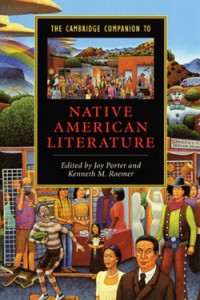Roemer, Kenneth M. The Cambridge Companion to Native American Literature. Introduction. Eds. Joy Porter and Kenneth M. Roemer. Cambridge: Cambridge UP, 2005. 1-35. Print.
In the introduction to the 2005 Cambridge Companion to Native American Literature, Roemer provides an extensive history of the emergence of ever-evolving field of Native American Literary Studies in the academy. Though Native American writers have published since the nineteenth century in multiple genres, it wasn’t until Vine Deloria, Jr.’s 1969 Custer Died for Your Sins, and the awarding of the 1969 Pulitzer Prize to the virtually unknown N. Scott Momaday for his novel House Made of Dawn, that work by Native American authors began to appear in the canon, let alone in literature courses.
As Roemer points out, the “increased visibility” (2) of American Indian literatures of course coincided with the Civil Rights, Feminist, and American Indian Movements of the 1970s and 1980s, and by the 1990s, numerous reference works and anthologies were circulating, including A. LaVonne Brown Ruoff’s 1990 American Indian Literatures, which many label as benchmark scholarship, to Joy Harjo and Gloria Bird’s 1997 multi-genre Reinventing the Enemy’s Language.
Roemer details the collaborative efforts between the MLA and the Association for the Study of American Indian Literatures since the 1970s, and distinguishes academic journals (such as Studies in American Indian Literatures, or SAILs) and university presses (such as the U of Nebraska Press) which provide a platform for critical scholarship in the field.
Just as Ostergaard and Nugent (2009), McComiskey (2006), and Miller (2011) debate the “crisis” of plurality in English Studies, so does Roemer acknowledge the suspicions that arise when a field is so broad. However, Roemer makes clear that to not embrace the diversity of this field is faulty, due to some of the complexities listed below. Roemer also categorizes the field through these complexities, discussing the field’s older and newer characteristics:
- Problems in naming the field (Native American, American Indian, Indigenous, Amerindian literature, etc.);
- Diversity of the field, stemming from: genre boundaries(written or oral, songs, ceremonies, speeches, fiction or nonfiction, a combination of all, etc.); cultural and regional implications, and cross-fertilization occurring between cultures and regions; language variations (especially the problems of translation into English or back into original language); intended experience of the literature (performance, ceremony, song, etc.);
- Undoing the privileging of certain genres over others, such as fiction and poetry over sermons or political essays or treaties, and maintaining the growth of new genres, such as drama and film;
- Undoing ideas of appropriate content, which “should be defined flexibly enough to include the huge diversity of the topic and the possibility of seemingly non-Indian subjects by Native viewpoints” (8).
- Revealing an epistemology based on attitudes about a shared history (such as “attitudes reflecting complex mixtures of post-apocalyptic worldviews”), an awareness of survival, a “hope that goes beyond survival…to sense of tribal and pan-tribal sovereignty and identity,” and the interconnections of communal identity, language, place, and time (11).
The only issue that Roemer seemingly fails to address in depth (though he does point to some scholarship) is the question of teaching American Indian Literature(s)–particularly if the instructor is not Native American.
One question I will then leave the reader with is how should (or should not) one teach American Indian Literary Studies, particularly if that teacher has only an outsider’s perspective? What are the special complications in this pedagogy, distinguishable from other studies based around race or racial experience?
